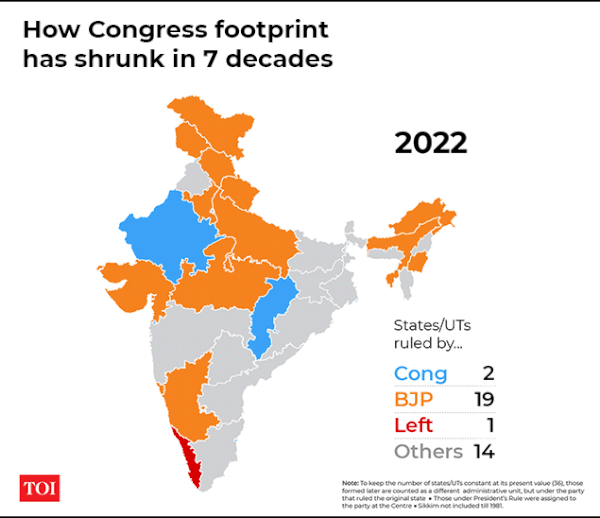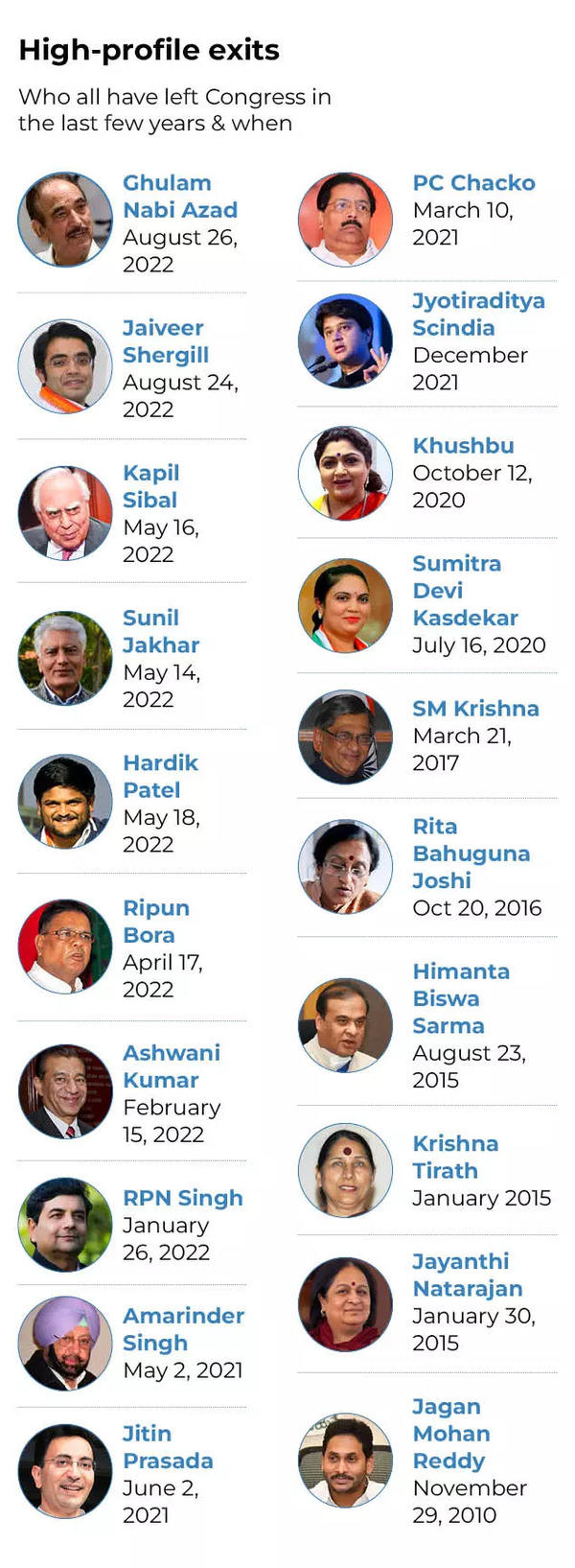Besides a spirited challenge from Shashi Tharoor, Kharge — a Gandhi loyalist — found little resistance in his journey to the top post in the party. But the real challenge is the road ahead.
As president, Kharge is taking over a party that is an ailing version of its past self, haunted by a series of electorial setbacks and the defection of top-rung leaders.
Moreover, being the first non-Gandhi chief to lead Congress in 24 years, Kharge will have the difficult task of maintaining an independent power centre while keeping the interests of the three Gandhis (SoniaRahul and Priyanka) aligned.
Here’s what is likely to be on Kharge’s mind as he takes over the coveted post …
Electoral kick-start
The first and most important task before Kharge would be to increase Congress’s electoral presence across India. Clearly, that can only be done by winning more state elections and arresting the party’s political slide.
While Congress had lost its absolute dominance by the time Sonia took charge in 1998, it was still a formidable force in many states. This is apparent from the map below.

In 2006, the UPA under Congress had governments in as many as 16 states across India. That’s just one fewer than the number of states presently under NDA rule.
But over the last decade or so, the Congress has been dislodged in over a dozen states by either BJP or some regional party. Even in states where it used to be the No. 2 party, the Congress is now relegated to the forgettable third or fourth position.
Currently, Congress has its own chief ministers in just two states: Rajasthan and Chhattisgarh. In Jharkhand and Bihar, it is part of the ruling alliance.
If Kharge hopes to revive Congress, he will have to ensure victories in more states, or at least in those where the party once enjoyed a strong presence.
However, seeing BJP’s unstoppable rise and Congress’s dwindling fortunes, the task seems quite steep.
The immediate test
Himachal Pradesh will go to polls on November 12. Elections are also due in Gujarat. This means that Kharge barely has enough time to marshall his resources and focus on the two poll-bound states.
So far, Congress has been running a rather insipid campaign in both Himachal and Gujarat.
Opinion polls are predicting a BJP landslide in Gujarat yet again. However, in Himachal, they are projecting a close contest.
An early electoral victory would come as a shot in the arm for Kharge and give him the boost he needs to lead the party out of the shadows.
But if the Congress fails to make any mark, the new party chief will be under greater pressure to deliver next year.
A ‘6-fold’ challenge
When Sonia first took the reins of Congress in 1998, the BJP had only just tasted electoral success on a national scale.
In 1998, the BJP-led NDA managed to form a shaky government under Atal Bihari Vajpayee despite a hung Parliament. The government fell a few months later but Vajpayee came to power again in 1999, this time with a more decisive mandate.
Between the two elections, the power in Congress switched hands from Sitaram Kesari to Sonia Gandhi.
Even though Congress lost its first elections under Sonia in 1999, it ended up with a higher vote share than that of BJP. It also managed to win 114 seats of its own, compared to BJP’s 182.
In the four Lok Sabha elections that followed, the Congress traced a symbolic political arc of glorious highs and dismal lows.
In both 2014 and 2019, BJP won around 6-times the number of seats Congress managed to secure. Thus, the challenge before Kharge is also 6-times greater.
Balancing act
When Sitaram Kesari was the Congress president before Sonia, he only had to answer to one Gandhi. That too a leader who had only just joined the party full time.
For Kharge, things are quite different.
The Karnataka leader is assuming charge at a time when all three members of the Gandhi family are actively involved in the party’s affairs.
Sonia Gandhi is the UPA chairperson, Priyanka Gandhi is the general secretary and Rahul Gandhi is the de facto head of the party.
As the head of Congress, Kharge will have to carefully balance the interests of all the Gandhi members to ensure harmony between the leadership and organisation.
Though Kharge has the backing of the Gandhis, he can ill-afford to appear as a puppet leader or one being guided by a remote control.
With key leaders within the party seeking organization reforms and questioning the leadership, Kharge will have to serve effectively as both — a liaison and an independent authority — to ensure smooth functioning in the long run.
Besides this, Kharge also faces the challenge of a generational divide in the party and has to maintain a balance between experience and the youth going forward.
‘Congress jodo’ mission
Rahul Gandhi may have embarked on a multi-state Bharat-jodo mission, but what the grand old party really needs is a Congress-Jodo mission.
Since the 2014 Lok Sabha defeat, the Congress has experienced a mass exodus of senior leaders – the latest being Ghulam Nabi Azad.
At least 460 leaders left Congress between 2014 and 2022.

Around 177 MPs/MLAs left the party during elections, while 222 electoral candidates left the Congress for other parties.
The leaders have quit Congress over multiple issues, from being unhappy with the style of functioning to not getting enough importance in the party.
Eventually, most of these defections have ended up hurting the party in some way or the other.
In the longer run, Kharge will have to find a way to stem these defections and ensure harmony between the old guard and the new.
Personal resume
As a tall Dalit leader from Karnataka, Kharge has had an impressive electoral record.
He is well-known for not losing an election barring the 2019 Lok Sabha poll from Gulbarga.
But for a leader tasked with steering the Congress out of its current mess, Kharge’s record with crisis management has not been quite impressive.
In 2014, Kharge was sent to Assam to quell the discontent within Congress after Himanta Biswa Sarma raised the banner of revolt against the then CM Tarun Gogoi.
Even though a majority of MLAs wanted Gogoi to be ousted, the Congress decided to persist with him. Consequently, Sarma switched over to BJP and helped the saffron party decimate Congress in Assam as well as other northeastern states.
Then, in 2021, Kharge was part of a three-member committee to resolve the crisis in Punjab triggered by a bitter tussle between Navjot Singh Sidhu and Amarinder Singh. Eventually, Amarinder was removed from the party and replaced with Charanjit Channi and Sidhu was elevated to the post of state chief.
However, the experiment did little to improve the party’s fortunes. It ended up losing the state to AAP.
Recently, Kharge was also sent to Rajasthan along with Ajay Maken to get a one-line resolution from Congress MLAs, authorising Sonia to select the next chief minister of the state if Ashok Gehlot goes on to become the party chief.
However, the MLAs staged a revolt at the prospect of Sachin Pilot becoming the chief minister and refused to attend a key party meeting. Eventually, Gehlot was asked to withdraw from the race of Congress presidential polls.
The fracas caused embarrassment to the party, especially at a time when Rahul Gandhi had embarked on the multi-state Bharat Jodo mission.
Thus, Kharge would hope to improve his crisis management skills if he hopes to resuscitate the grand old party.
While the Rajasthan crisis has been nipped in the bud for now, it is sure to rear its ugly head again next year when the elections close in. Kharge will have to delicately manage the growing tensions between Gehlot and Pilot and find an amicable solution.
CWC elections
On Day 1 of taking charge, Kharge constituted a 47-member steering committee which will function in place of the Congress Working Committee (CWC).
There has been growing demand within the party to hold elections for CWC. It was in 1997 when the last CWC elections were held.
CWC is the highest decision-making body of the party and has the final authority on every crucial decision. According to the Congress constitution, the CWC is comprised of the working president, the leader of the party and 23 other members. Out of these 23, 12 are elected by the All India Congress Committee and the remaining are nominated by the party president.
Kharge is expected to reconstitute the CWC soon after the party’s plenary session next year.
The challenge before Kharge would be to coordinate closely with Team Rahul Gandhi while filling the posts.
Notably, Shashi Tharoor, who challenged Kharge for the top post, did not find a place in the new steering committee. It is hard to say if he will be considered for the CWC, despite some leaders demanding the Thiruvananthapuram MP’s inclusion in the top panel.
Karnataka challenge
In 2023, the Congress president will face the onerous task of leading the party in as many as nine assembly elections, including in his home state Karnataka.
Karnataka will be of particular importance for Kharge since it’s his home state and the Congress is desperately seeking a comeback there.
The party was part of a short-lived government led by JD(S) before it was ousted from power by the BJP in 2019.
Kharge will have to play an instrumental role in resolving the infighting between two frontline leaders: Siddaramaiah and DK Shivakumar
Besides that, he also will be expected to swing the dalit votes in Congress’s favour.
(With inputs from agencies)






